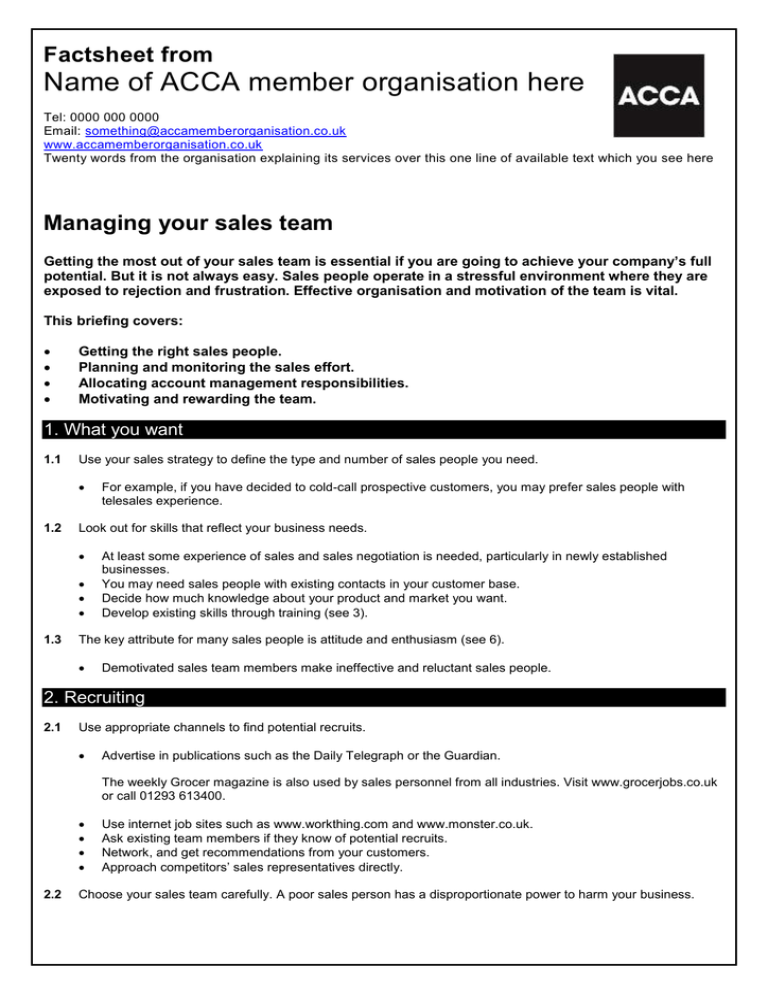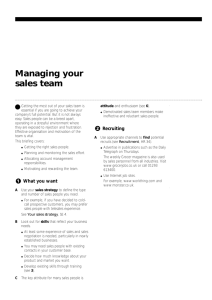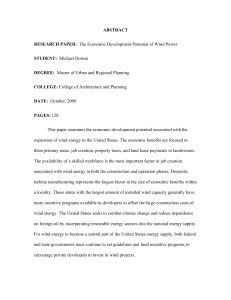
Factsheet from
Name of ACCA member organisation here
Tel: 0000 000 0000
Email: something@accamemberorganisation.co.uk
www.accamemberorganisation.co.uk
Twenty words from the organisation explaining its services over this one line of available text which you see here
Managing your sales team
Getting the most out of your sales team is essential if you are going to achieve your company’s full
potential. But it is not always easy. Sales people operate in a stressful environment where they are
exposed to rejection and frustration. Effective organisation and motivation of the team is vital.
This briefing covers:
Getting the right sales people.
Planning and monitoring the sales effort.
Allocating account management responsibilities.
Motivating and rewarding the team.
1. What you want
1.1
Use your sales strategy to define the type and number of sales people you need.
1.2
Look out for skills that reflect your business needs.
1.3
For example, if you have decided to cold-call prospective customers, you may prefer sales people with
telesales experience.
At least some experience of sales and sales negotiation is needed, particularly in newly established
businesses.
You may need sales people with existing contacts in your customer base.
Decide how much knowledge about your product and market you want.
Develop existing skills through training (see 3).
The key attribute for many sales people is attitude and enthusiasm (see 6).
Demotivated sales team members make ineffective and reluctant sales people.
2. Recruiting
2.1
Use appropriate channels to find potential recruits.
Advertise in publications such as the Daily Telegraph or the Guardian.
The weekly Grocer magazine is also used by sales personnel from all industries. Visit www.grocerjobs.co.uk
or call 01293 613400.
2.2
Use internet job sites such as www.workthing.com and www.monster.co.uk.
Ask existing team members if they know of potential recruits.
Network, and get recommendations from your customers.
Approach competitors’ sales representatives directly.
Choose your sales team carefully. A poor sales person has a disproportionate power to harm your business.
2.3
Plan thoroughly before you interview.
Involve existing team members in the recruitment process.
Make sure team managers have the right skills for their roles (see 6.2).
Use an appropriate employment contract.
Many contracts include a clause that aims to limit sales people’s ability to take customers away when they
leave.
Set out a code of conduct and define clearly what is unacceptable behaviour.
For example, poaching customers from other sales people or submitting ‘creative’ expenses forms.
2.4
Use competitive remuneration to help attract and retain good sales people.
The aim is to achieve an appropriate balance between basic and incentive pay (see box, page 3).
Low-basic, high-commission pay structures are often suitable for young firms, as they keep fixed costs down.
Use basic pay to reflect the importance of sales activities that do not generate commission, such as
customer care.
If individual sales people’s efforts have little effect on sales performance, you may offer higher basic pay. For
example, the job may consist largely of order-taking rather than selling.
If the pay package includes significant performance-related pay, you will need to convince sales people that
your company offers good sales potential.
Consider other ‘perks’ that sales people may find attractive.
For example, a company car.
Be aware that high sales remuneration can cause conflict with other employees in less well-paid areas. Make
sure sales people’s pay packages can be justified.
3. Training and development
3.1
New recruits will need a basic induction.
Give them information about your products, company and market.
Brief new recruits on your company sales strategy and policy. Ensure they understand your standard terms
and conditions of sale.
Spell out all other relevant details.
For example, your policy on dress code, travel expenses and entertainment costs.
3.2
Monitor and develop employees’ customer contact skills.
3.3
Use individual coaching to build confidence and expertise.
3.4
Many sales people need to improve their listening skills and learn how to ask intelligent questions.
Use rehearsal and role-play to develop your team’s customer contact expertise.
Develop sales people’s negotiation skills.
Set up relevant training courses and monitor their impact.
Accompany individual sales people to key meetings so you can observe them in action and give meaningful,
objective feedback.
Plan opportunities to meet and motivate employees, before and after sales calls (see 6).
Work with sales people individually to overcome problems, build strengths and provide opportunities for
development.
Monitor progress by holding quarterly performance appraisals.
2
Be positive. Focus on opportunities to improve performance.
Pay particular attention to those areas where employees may feel little incentive to perform.
For example, keeping good sales records.
Discuss with individuals whether underperformance is their own fault or a problem with some aspect of your
sales strategy or sales support.
4. Team objectives
4.1
Work with your sales team to set sales targets.
4.2
Negotiation is essential to secure sales people’s involvement.
Be aware that sales people are often keen to focus on customers who bring them short-term benefits.
Agree monthly targets based on your sales forecasts.
Set targets for individual accounts, individual team members and different sales teams.
Avoid setting targets too high. Failure to achieve unrealistic targets can demotivate your team.
Avoid raising targets because of previous good performance. It is better to agree increases based on the
company’s overall performance.
Agree key performance indicators.
Define what number of sales should come from which number of visits, calls or contacts — your sales
‘conversion rate’.
Set out the sales and contribution required from each sales person.
Assess levels of customer retention and repeat business.
Beware of setting the wrong indicators.
For example, measuring the number of telephone calls made might be appropriate for simple telesales but
not for managing key accounts.
4.3
Monitor individual performance in weekly one-to-one meetings.
Base monitoring on the key performance indicators.
Concentrate on assessing the profitability of sales activities, rather than volume.
Understand the challenges of different accounts or territories that may be more difficult to sell to. It may be
necessary to adjust your targets.
Use individual performance monitoring to identify weak links.
Use tracking software to help improve your understanding of sales people’s performance, and your ability to
develop them.
5. Organising the team
5.1
Plan your sales team’s activities using your sales strategy.
Clearly communicate your sales objectives.
For example, in relation to new and existing businesses.
5.2
Outline how you want to deal with different accounts.
Agree how much time is to be allocated selling different products, to different types of customer, in different
areas.
Agree a sales budget. For example, for any promotional material or equipment the sales team require (see
box, page 2).
Tell the team about sales margins and pricing.
Set out your policy on incentive pay (see box, page 3).
Allocate responsibility for different accounts, products or geographical territories.
3
It is wise to negotiate responsibility with individuals in the sales team.
Keep to a minimum the number of people handling each account. Many customers prefer a single account
manager, even if other individuals are involved in selling particular products.
Maximise your sales team’s productive time by using sales support and customer service employees.
Put your best sales people into new sales initiatives, letting you benchmark what can be achieved.
Where different sales people are handling the same account, set out how they will communicate (see 5.4).
Be aware of the danger of creating conflict between team members.
For example, if two people both feel they have contributed to making a sale, or both want to be allocated a
profitable client.
5.3
Set clear ground rules for the level of responsibility and freedom sales people have. For example, agree whether
they decide when to contact customers, or if they have to follow a set call plan.
Outline how far sales people can plan and carry out customer contacts independently.
For example, telesales might follow a script, routine sales contacts would be handled independently, and key
sales people would plan (and attend) key meetings.
5.4
Set out what budgets are available for travel and customer entertainment.
Tell sales people what freedom they have to negotiate discounts.
Organise and communicate information.
Get sales people to complete weekly sales activities reports.
Hold weekly team meetings, monthly for field-based employees. Share news and discuss problems.
Get sales people to report back customer comments, enquiries and complaints.
Agree priorities for the next week or month, including specific objectives.
Allow sales people to access sales information using an extranet or internet service such as
www.salesforce.com/uk.
6. Motivating the team
The motivation and support of your sales team is a key factor in achieving your sales and business objectives.
6.1
Give sales people the support they need.
6.2
Improve team managers’ leadership skills.
6.3
This is particularly important for team members responsible for winning major contracts.
Hold regular one-to-one meetings to discuss objectives, performance and problems. Watch out for signs of
low morale or personal problems.
Take every opportunity to praise, congratulate and motivate.
Work to minimise stress levels among employees.
As well as being good sales people, team leaders must also have strong organisational and administrative
skills.
Team leaders need to be a coach, listening to, supporting and developing each team member.
Work to build the team.
Keep a league table of team and individual achievements.
For example, identify territories or customers where sales have been particularly successful and reward all
those involved in that success, including support and customer service employees.
Plan social events for the team to relax together.
4
Using the right tools
A.
Provide appropriate sales materials.
B.
Create a set of standard documents, such as call sheets, standard contracts and proposal forms.
Provide promotional material. For example, brochures and price lists.
Give support documentation, such as telesales scripts.
Give your sales team the equipment they need.
A good database is essential.
Your sales team may need powerful contact management software if you have many high-value customers.
Mobile phones and laptop computers are basic tools of the trade.
Incentive pay
A.
Structure incentive pay to reflect your business objectives.
B.
For example, do not pay commission based on sales volume if your aim is to increase the number of highmargin sales you make.
Use incentive pay structures that reflect the challenges of the sales environment.
Rates of commission should be linked to the selling price, and to the amount of effort needed to make the
sale.
It could range from 5 per cent, if the product is easy to sell, to higher rates if a major effort is needed.
Offer weekly or monthly bonuses for sales people working in competitive markets, such as advertising.
Review incentive pay annually and adjust as necessary.
Experts’ quotes
“If you plan to introduce non-sales people into selling roles, you may need to overcome sales aversion. Gradually wean
employees into the role, by inviting them to attend internal sales meetings and customer visits.”
June Lonsdale, Anglo Recycling Technology Ltd.
Expert contributors
Thanks to Guy Aston (Huthwaite International, 01709 710081).
Last reviewed 01.04.11
© Atom Content Marketing 2011. ISSN 1369-1996. All rights reserved. No part of this publication may be reproduced or transmitted without the
written permission of the publisher. This publication is for general guidance only. The publisher, expert contributors and distributor disclaim all liability
for any errors or omissions. Consult your local business support organisation or your professional adviser for help and advice.
5




